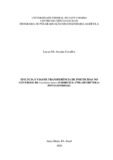| dc.creator | Cavallin, Lucas de Arruda | |
| dc.date.accessioned | 2021-12-16T12:28:02Z | |
| dc.date.available | 2021-12-16T12:28:02Z | |
| dc.date.issued | 2020-02-28 | |
| dc.identifier.uri | http://repositorio.ufsm.br/handle/1/23334 | |
| dc.description.abstract | The neotropical brown stink bug, Euschistus heros (Fabricius, 1798) (Hemiptera: Pentatomidae), is considered the main soybean pest in Brazil. This study presents two manuscripts that aim to understand the efficacy of insecticides, how insecticides contamination occurs, and which are the most important transfer mode of insecticides for mortality of E. heros. The first research entitled "Efficacy of insecticides in the control of Euschistus heros (Fabricius, 1798) (Hemiptera: Pentatomidae) in soybeans, in two edaphoclimatic regions of Rio Grande do Sul" found that the control efficacy of nymphs in Santa Maria ranged between 29,6% and 77.3%, and of adults ranged between 66.2% and 92.3%. In Capão do Cipó locality, the control of E. heros varied between 45.4% and 77.3%. The best efficacy was accomplished by Curbix + Evidance (500 mL + 143 g ha-¹) and Orthene (1000 g ha-¹) in both locations. In Santa Maria locality, Expedition (300 mL ha-¹), Engeo Pleno S (250 mL ha-¹), Sperto (250 mL ha-¹) and Galil (400 mL ha-¹) were the most effective. The second manuscript entitled "Insecticide transfer mode in Euschistus heros (Fabricius, 1798) (Hemiptera: Pentatomidae)", found differences in susceptibility among E. heros populations, depending on the via of insecticides transferring. Insecticide transferred via topical contact, tarsal contact and via ingestion were effective in the control of E. heros, however, it differs with the type of insecticide. Mortality of E. heros based on the via of respiratory system was extremely low, varying between 10.0% and 21.7%. The mortality of E. heros via ingestion was highly dependent of the treatment and ranged between 8% and 91.3%. However, the mortality via topical contact, tarsal contact and tarsal contact + ingestion was up to 100%. Therefore, understanding the effectiveness and via of insecticide transferring into E. heros, provides support to make the best decisions in the field, and to ensure an effective control of E. heros in soybeans. | eng |
| dc.description.sponsorship | Coordenação de Aperfeiçoamento de Pessoal de Nível Superior - CAPES | por |
| dc.language | por | por |
| dc.publisher | Universidade Federal de Santa Maria | por |
| dc.rights | Attribution-NonCommercial-NoDerivatives 4.0 International | * |
| dc.rights.uri | http://creativecommons.org/licenses/by-nc-nd/4.0/ | * |
| dc.subject | Percevejo-marrom | por |
| dc.subject | Controle químico | por |
| dc.subject | Contaminação | por |
| dc.subject | Neotropical brown stink bug | eng |
| dc.subject | Chemical control | eng |
| dc.subject | Contamination | eng |
| dc.title | Eficácia e vias de transferência de inseticidas no controle de Euschistus heros (Fabricius, 1798) (Hemiptera: Pentatomidae) | por |
| dc.title.alternative | Efficacy and insecticides transfer modes to control Euschistus heros (Fabricius, 1798) (Hemiptera: Pentatomidae) | eng |
| dc.type | Dissertação | por |
| dc.description.resumo | O percevejo-marrom, Euschistus heros (Fabricius, 1798) (Hemiptera: Pentatomidae), é considerado a principal praga da soja no Brasil. Este trabalho teve como objetivos compreender a eficácia dos inseticidas, como ocorre a contaminação e quais são as vias de transferências dos inseticidas na mortalidade de E. heros. O primeiro artigo intitulado “Eficácia de inseticidas no controle de Euschistus heros (Fabricius, 1798) (Hemiptera: Pentatomidae) em soja, em duas regiões edafoclimáticas do Rio Grande do Sul” verificou que a eficácia de controle de ninfas em Santa Maria variou entre 29,6% e 77,3%, e de adultos entre 66,2% e 92,3%. Em Capão do Cipó, o controle de E. heros variou entre 45,4% e 77,3%. Os melhores resultados ficaram com Curbix + Evidance (500 mL + 143 g ha-¹) e Orthene (1000 g ha-¹) em ambos locais, e em Santa Maria, Expedition (300 mL ha-¹), Engeo Pleno S (250 mL ha-¹), Sperto (250 mL ha-¹) e Galil (400 mL ha-¹) foram eficazes. O segundo artigo intitulado “Vias de transferência de inseticidas em Euschistus heros (Fabricius, 1798) (Hemiptera: Pentatomidae)”, verificou diferença na suscetibilidade entre as populações de E. heros nas distintas vias de transferência. As vias de transferências de inseticidas por contato tópico, contato tarsal e ingestão foram eficazes no controle de E. heros, entretanto, é variável com o tipo de inseticida. A mortalidade via sistema respiratório foi extremamente baixa, variando entre 10,0% e 21,7%. A mortalidade de E. heros via ingestão foi muito dependente do tratamento, e variou entre 8% e 91,3%. Por outro lado, a mortalidade via contato tópico, contato tarsal e contato tarsal + ingestão foi de até 100%. Portanto, compreender a eficácia e as vias de transferências de inseticidas em E. heros, fornece suporte para tomar as melhores decisões no campo, e garantir o controle eficaz de E. heros em soja. | por |
| dc.contributor.advisor1 | Guedes, Jerson Carus | |
| dc.contributor.advisor1Lattes | http://lattes.cnpq.br/0846418627719511 | por |
| dc.contributor.referee1 | Perini, Clérison Régis | |
| dc.contributor.referee2 | Stürmer, Glauber Renato | |
| dc.creator.Lattes | http://lattes.cnpq.br/8397223239099525 | por |
| dc.publisher.country | Brasil | por |
| dc.publisher.department | Engenharia Agrícola | por |
| dc.publisher.initials | UFSM | por |
| dc.publisher.program | Programa de Pós-Graduação em Engenharia Agrícola | por |
| dc.subject.cnpq | CNPQ::CIENCIAS AGRARIAS::ENGENHARIA AGRICOLA | por |
| dc.publisher.unidade | Centro de Ciências Rurais | por |



